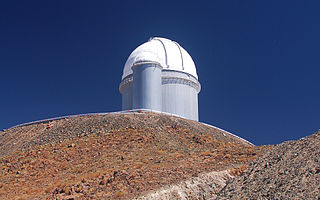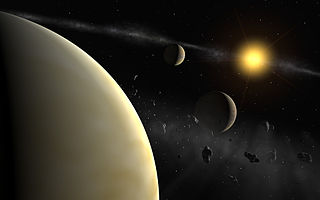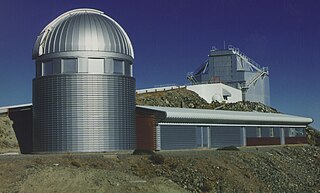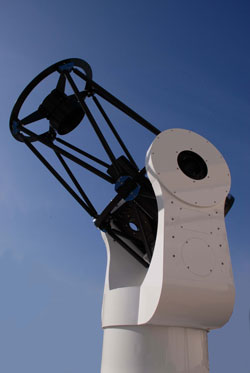
Lalande 21185 is a star in the south of Ursa Major. It is the apparent brightest red dwarf in the northern hemisphere. Despite this, and being relatively close by, it is very dim, being only magnitude 7.5 in visible light and thus too faint to be seen with the unaided eye. The star is visible through a small telescope or binoculars.

Michel Gustave Édouard Mayor is a Swiss astrophysicist and professor emeritus at the University of Geneva's Department of Astronomy. He formally retired in 2007, but remains active as a researcher at the Observatory of Geneva. He is co-laureate of the 2019 Nobel Prize in Physics along with Jim Peebles and Didier Queloz, and the winner of the 2010 Viktor Ambartsumian International Prize and the 2015 Kyoto Prize.

The ESO 3.6 m Telescope is an optical reflecting telescope run by the European Southern Observatory at La Silla Observatory, Chile since 1977, with a clear aperture of about 3.6 metres (140 in) and 8.6 m2 (93 sq ft) area.

The High Accuracy Radial Velocity Planet Searcher (HARPS) is a high-precision echelle planet-finding spectrograph installed in 2002 on the ESO's 3.6m telescope at La Silla Observatory in Chile. The first light was achieved in February 2003. HARPS has discovered over 130 exoplanets to date, with the first one in 2004, making it the most successful planet finder behind the Kepler space observatory. It is a second-generation radial-velocity spectrograph, based on experience with the ELODIE and CORALIE instruments.

WASP or Wide Angle Search for Planets is an international consortium of several academic organisations performing an ultra-wide angle search for exoplanets using transit photometry. The array of robotic telescopes aims to survey the entire sky, simultaneously monitoring many thousands of stars at an apparent visual magnitude from about 7 to 13.

HD 69830 d is an exoplanet likely orbiting within the habitable zone of the star HD 69830, the outermost of three such planets discovered in the system. It is located approximately 40.7 light-years (12.49 parsecs, or 3.8505×1014 km) from Earth in the constellation of Puppis. The exoplanet was found by using the radial velocity method, from radial-velocity measurements via observation of Doppler shifts in the spectrum of the planet's parent star.

Stéphane Udry is an astronomer at the Geneva Observatory in Switzerland, whose current work is primarily the search for extra-solar planets. He and his team, in 2007, discovered a possibly terrestrial planet in the habitable zone of the Gliese 581 planetary system, approximately 20 light years away in the constellation Libra. He also led the observational team that discovered HD 85512 b, another most promisingly habitable exoplanet.

Doppler spectroscopy is an indirect method for finding extrasolar planets and brown dwarfs from radial-velocity measurements via observation of Doppler shifts in the spectrum of the planet's parent star. As of November 2022, about 19.5% of known extrasolar planets have been discovered using Doppler spectroscopy.

WASP-13b, also known as Cruinlagh, is an extrasolar planet that was discovered in 2008 in the orbit of the sunlike star WASP-13. The planet has a mass of nearly half that of Jupiter, but a radius five-quarters of the size of Jupiter. This low relative mass might be caused by a core that is of low mass or that is not present at all.

WASP-15b, formally named Asye, is an extrasolar planet discovered in 2008 by the SuperWASP collaboration, which seeks to discover exoplanets that transit their host stars. The planet orbits its host star at a distance of 0.05 AU every four days. The mass of this planet is about one half that of Jupiter, but its radius is nearly 50% larger than Jupiter's, making the density of this planet only one quarter that of water; it is thought that some other form of heating must explain its extremely low density. WASP-15b's discovery was published on April 29, 2009.
HD 154672 b is an extrasolar planet located approximately 210 light-years away in the constellation of Ara, orbiting the metal-rich and aged star HD 154672. This planet has a minimum mass five times that of Jupiter and orbits at about 60% the distance between the Earth to the Sun. Its orbit is very elliptical, which causes temperatures on the planet to vary significantly as it proceeds along its orbit. This planet was discovered in Las Campanas Observatory on September 5, 2008 using the radial velocity method. Along with HD 205739 b, the planets were the first to be discovered by the N2K Consortium using the Magellan Telescopes.

Leonhard Euler Telescope, or the Swiss EULER Telescope, is a national, fully automatic 1.2-metre (47 in) reflecting telescope, built and operated by the Geneva Observatory. It is located at an altitude of 2,375 m (7,792 ft) at ESO's La Silla Observatory site in the Chilean Norte Chico region, about 460 kilometers north of Santiago de Chile. The telescope, which saw its first light on 12 April 1998, is named after Swiss mathematician Leonhard Paul Euler.

The Magellan Planet Search Program is a ground-based search for extrasolar planets that makes use of the radial velocity method. It began gathering data in December 2002 using the MIKE echelle spectrograph mounted on the 6.5m Magellan II "Clay" telescope located within the Las Campanas Observatory in Chile. In 2010, the program began using the newly commissioned Planet Finder Spectrograph (PFS), an instrument purpose-built for precise radial velocity measurement.

An exoplanet is a planet located outside the Solar System. The first evidence of an exoplanet was noted as early as 1917, but was not recognized as such until 2016; no planet discovery has yet come from that evidence. What turned out to be the first detection of an exoplanet was published among a list of possible candidates in 1988, though not confirmed until 2003. The first confirmed detection came in 1992, with the discovery of terrestrial-mass planets orbiting the pulsar PSR B1257+12. The first confirmation of an exoplanet orbiting a main-sequence star was made in 1995, when a giant planet was found in a four-day orbit around the nearby star 51 Pegasi. Some exoplanets have been imaged directly by telescopes, but the vast majority have been detected through indirect methods, such as the transit method and the radial-velocity method. As of 1 May 2024, there are 5,662 confirmed exoplanets in 4,169 planetary systems, with 896 systems having more than one planet. This is a list of the most notable discoveries.
The Lick–Carnegie Exoplanet Survey (LCES) is a search for exoplanets using the Keck I optical telescope of the W. M. Keck Observatory in Hawaii. The survey is sponsored by NASA and the National Science Foundation. The survey comprises a decade of observations. The survey is led by Steven Vogt, professor of astronomy and astrophysics at University of California at Santa Cruz, and R. Paul Butler of the Carnegie Institution.

ESPRESSO is a third-generation, fiber fed, cross-dispersed, echelle spectrograph mounted on the European Southern Observatory's Very Large Telescope (VLT). The unit saw its first light with one VLT in December 2017 and first light with all four VLT units in February 2018.

The Next-Generation Transit Survey (NGTS) is a ground-based robotic search for exoplanets. The facility is located at Paranal Observatory in the Atacama desert in northern Chile, about 2 km from ESO's Very Large Telescope and 0.5 km from the VISTA Survey Telescope. Science operations began in early 2015. The astronomical survey is managed by a consortium of seven European universities and other academic institutions from Chile, Germany, Switzerland, and the United Kingdom. Prototypes of the array were tested in 2009 and 2010 on La Palma, and from 2012 to 2014 at Geneva Observatory.

Ross 128 b is a confirmed Earth-sized exoplanet, likely rocky, that is orbiting within the inner habitable zone of the red dwarf star Ross 128, at a distance of around 11 light-years from Earth. The exoplanet was found using a decade's worth of radial velocity data using the European Southern Observatory's HARPS spectrograph at the La Silla Observatory in Chile. Ross 128 b is the nearest exoplanet around a quiet red dwarf, and is considered one of the best candidates for habitability. The planet is only 35% more massive than Earth, receives only 38% more starlight, and is expected to be a temperature suitable for liquid water to exist on the surface, if it has an atmosphere.
MINERVA-Australis is a dedicated exoplanet observatory, operated by the University of Southern Queensland, in Queensland, Australia. The facility is located at USQ's Mount Kent Observatory, and saw first light in quarter two 2018. Commissioning of the facility was completed in mid-2019, and the facility was officially launched on 23 July 2019.

Teegarden's Star b is an exoplanet found orbiting within the habitable zone of Teegarden's Star, an M-type red dwarf 12.5 light years away from the Solar System. It had the highest Earth Similarity Index (ESI) of any exoplanet, but in February 2024 a new study updated the parameters of the planet, thus reducing its ESI to 0.90, making it no longer the planet with the hightest ESI. Along with Teegarden's Star c, it is among the closest known potentially habitable exoplanets.





















